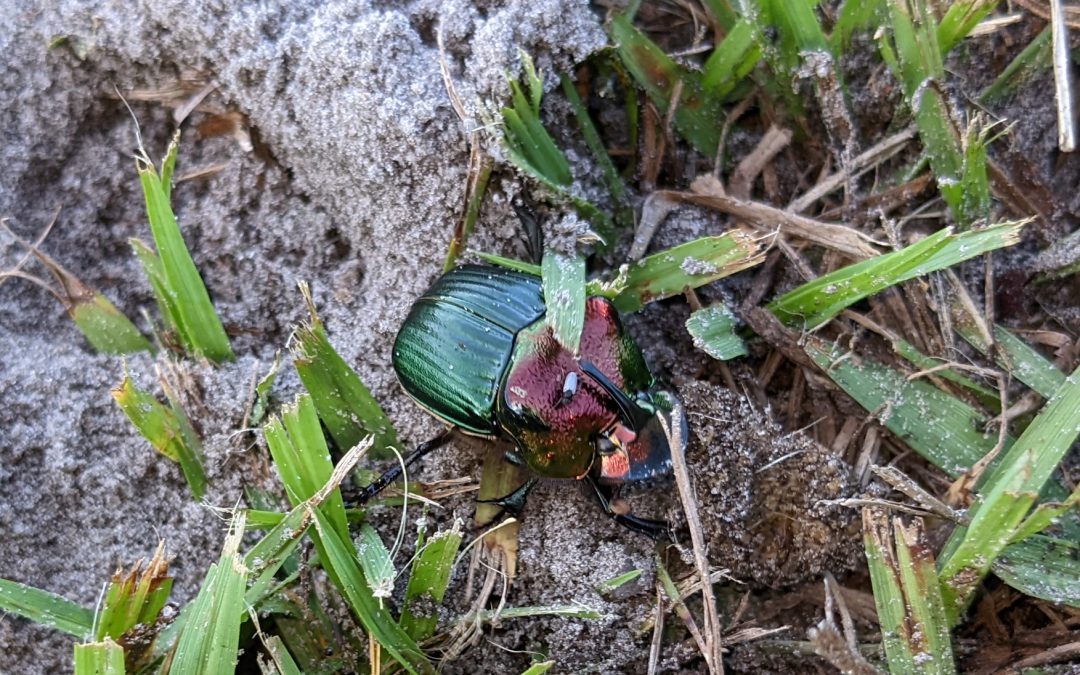
by Erik Lovestrand | Jul 21, 2022
Most of us have had the displeasure of hurrying to our car, late for some appointment, climbing in, only to be assaulted by…sniff-sniff…the overpowering stench of doggy poo on a shoe. I can handle many of nature’s nasty smells pretty well but this one nearly gags me. Imagine if this stuff never went away and kept accumulating on the ground. For any of us that have even one big dog, this would be a problem. Heaven help the dog lovers out there with two or more large canines. Well, this article will be paying homage to the unsung heroes of the manure-removal squad, who could give Mike Rowe a run for his money any day. You guessed it, dung beetles.
Dung beetles are most assuredly not the only critters who make their living by what we would consider disgusting means. Carrion beetles, fly maggots, vultures and many other creatures would qualify for an episode of “Dirty Jobs in the Animal Kingdom.” However, the incredible beauty of many species of scarab beetles (the group to which dung beetles belong), resulted in high reverence in the ancient Egyptian culture. In more recent times, humans have realized the benefits provided by dung beetles and have intentionally introduced them in some places to manage dung accumulation in pasture systems. Their tunneling not only takes the dung below for a nutrient recycling function but also brings soil castings to the surface, which reduces soil compaction and improves aeration.
I have seen dung beetles many times, as they work in the yard to reduce my chances of “stepping in it.” Until recently, I have not paid close attention to the incredible beauty of our local species. I had a great opportunity the other day to observe several beetles as they reduced a pile of dog mess to smaller messes and pulled them into their tunnels for long-term storage. The showy, metallic colors of red and green made it apparent why some refer to these creatures as “rainbow” scarabs. They were happy to ignore my presence as I took pictures only inches away from their frenzied activity to salvage their prized doggy treats.
The dung serves as food for both young and adults during periods when they remain underground. Females lay a single egg on what is referred to as a “brood ball” of dung and there may be several of these pre-packaged meals with an egg in the tunnel system made by the beetles. I was able to get some good photos of a beetle as it worked above ground moving dung balls away from the mother lode. It appears to be a species known as Phanaeus igneus, which occurs in our area along with a similar species named Phanaeus vindex. In Florida, Phanaeus igneus tends to occur in sandy soils, while P. vindex prefers clay-type soils. The finely sculptured elytra (hard wing covers) of P. igneus also distinguish it from P. vindex. Eggs hatch into a grub that matures below ground before emerging as a mature adult to continue the cycle.
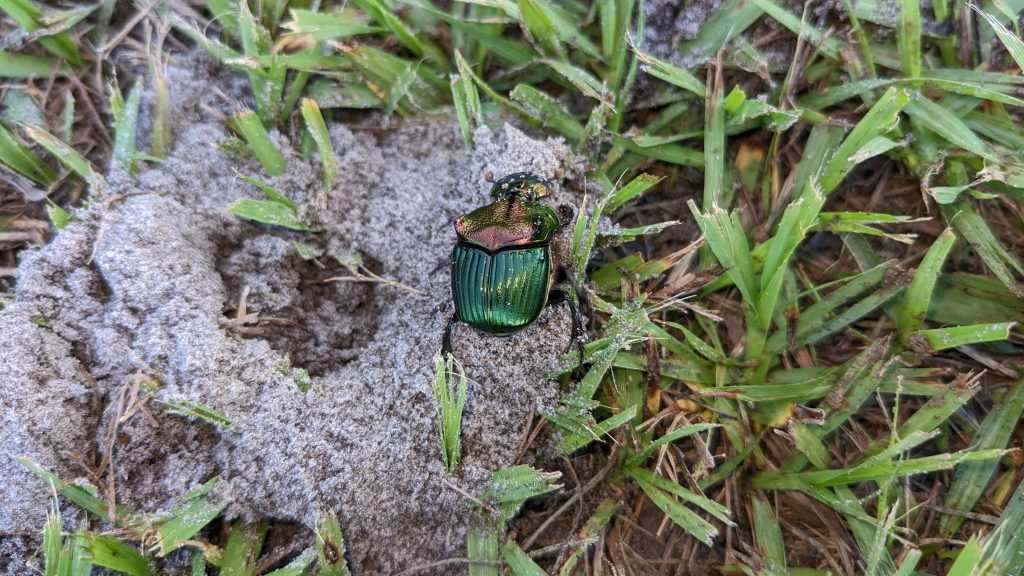
Females of this species are distinguished from males by the lack of a horn.
The dung beetle’s sense of smell is truly a wonder of nature. I have seen them flying in for a sniff test literally within minutes of deposition. Within the next day or two, the only evidence of your pooch’s crime will be small mounds of soil where the excavations took place. I was so taken with these little jewels of the manure pile that you might understand why I think you should be just as amazed. So, the next time you find a fresh pile in the yard, drop down to your knees for a closer look and be prepared to be amazed. If the manure-removal squad has not appeared on the scene yet, give them a few minutes. It won’t take very long. In the meantime, you can be thinking about how you will explain your behavior to your neighbors when they inquire.
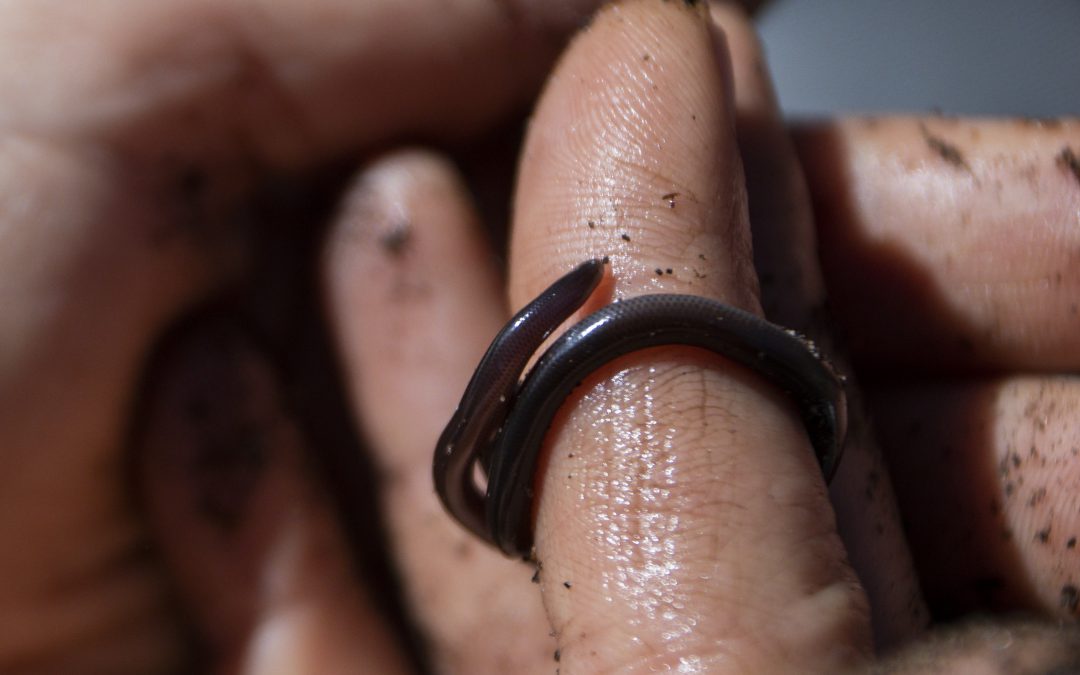
by Scott Jackson | May 26, 2022
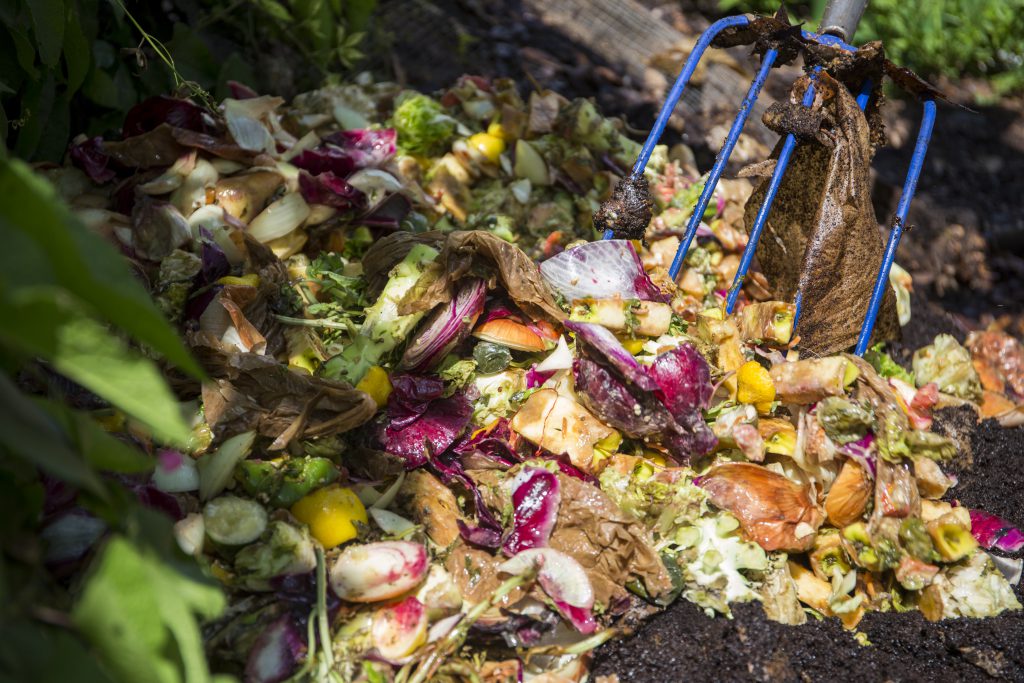
Nutrients found in food waste are too valuable to just toss away. Small scale composting and vermicomposting provide opportunity to recycle food waste even in limited spaces. UF/IFAS Photo by Camila Guillen.
During the summer season, my house is filled with family and friends visiting on vacation or just hanging out on the weekends. The kitchen is a popular place while waiting on the next outdoor adventure. I enjoy working together to cook meals, bbq, or just make a few snacks. Despite the increased numbers of visitors during this time, some food is leftover and ultimately tossed away as waste. Food waste occurs every day in our homes, restaurants, and grocery stores and not just this time of year.
The United States Food and Drug Administration estimates that 30 to 40 percent of our food supply is wasted each year. The United States Department of Agriculture cites food waste as the largest type of solid waste at our landfills. This is a complex problem representing many issues that require our attention to be corrected. Moving food to those in need is the largest challenge being addressed by multiple agencies, companies, and local community action groups. Learn more about the Food Waste Alliance at https://foodwastealliance.org
According to the program website, the Food Waste Alliance has three major goals to help address food waste:
Goal #1 REDUCE THE AMOUNT OF FOOD WASTE GENERATED. An estimated 25-40% of food grown, processed, and transported in the U.S. will never be consumed.
Goal #2 DONATE MORE SAFE, NUTRITIOUS FOOD TO PEOPLE IN NEED. Some generated food waste is safe to eat and can be donated to food banks and anti-hunger organizations, providing nutrition to those in need.
Goal #3 RECYCLE UNAVOIDABLE FOOD WASTE, DIVERTING IT FROM LANDFILLS. For food waste, a landfill is the end of the line; but when composted, it can be recycled into soil or energy.
All these priorities are equally important and necessary to completely address our country’s food waste issues. However, goal three is where I would like to give some tips and insight. Composting food waste holds the promise of supplying recycled nutrients that can be used to grow new crops of food or for enhancing growth of ornamental plants. Composting occurs at different scales ranging from a few pounds to tons. All types of composting whether big or small are meaningful in addressing food waste issues and providing value to homeowners and farmers. A specialized type of composting known as vermicomposting uses red wiggler worms to accelerate the breakdown of vegetable and fruit waste into valuable soil amendments and liquid fertilizer. These products can be safely used in home gardens and landscapes, and on house plants.
Composting meat or animal waste is not recommended for home composting operations as it can potentially introduce sources of food borne illness into the fertilizer and the plants where it is used. Vegetable and Fruit wastes are perfect for composting and do not have these problems.
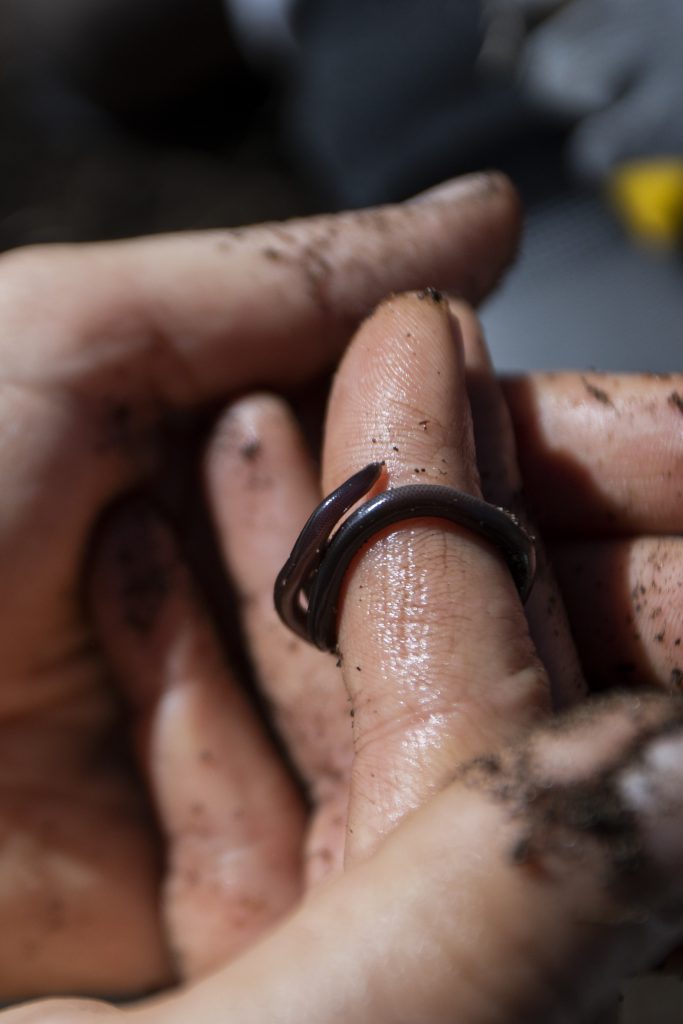
Composting worms help turn food waste into valuable fertilizer. UF/IFAS Photo by Tyler Jones
Detailed articles on how vermicomposting works are provided by Tia Silvasy, UF/IFAS Extension Orange County at https://blogs.ifas.ufl.edu/orangeco/2020/12/10/vermicomposting-using-worms-for-composting and https://sfyl.ifas.ufl.edu/media/sfylifasufledu/orange/hort-res/docs/pdf/021-Vermicomposting—Cheap-and-Easy-Worm-Bin.pdf Supplies are readily available and relatively inexpensive. Please see the above links for details.
A small vermicomposting system would include:
• Red Wiggler worms (local vendors or internet)
• Two Plastic Storage Bins (approximately 30” L x 20” W x 17” H) with pieces of brick or stone
• Shredded Paper (newspaper or other suitable material)
• Vegetable and Fruit Scraps
Red Wiggler worms specialize in breaking down food scraps unlike earthworms which process organic matter in soil. Getting the correct worms for vermicomposting is an important step. Red Wigglers can consume as much as their weight in one day! Beginning with a small scale of 1 to 2 pounds of worms is a great way to start. Sources and suppliers can be readily located on the internet.
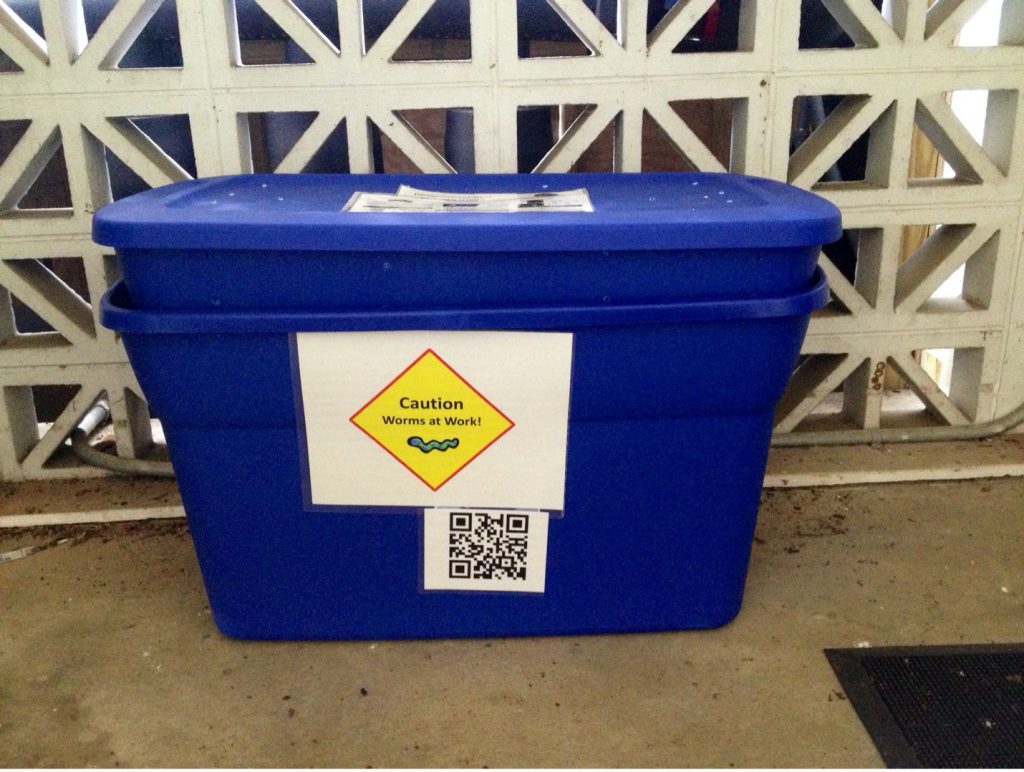
Worm “homes” can be constructed from two plastic storage bins with air holes drilled on the top. Additional holes put in the bottom of the inner bin to drain liquid nutrients. Pieces of stone or brick can be used to raise the inner bin slightly. Picture provided by UF/IFAS Extension Leon County, Molly Jameson
Once the worms and shredded paper media have been introduced into the bins, you are ready to process kitchen scraps and other plant-based leftovers. Food waste can be placed in the worm bins by moving along the bin in sections. Simply rotate the area where the next group of scraps are placed. See example diagram. For additional information or questions please contact our office at 850-784-6105.

Placing food scraps in a sequential order allows worms to find their new food easily. Contributed diagram by L. Scott Jackson
Portions of this article originally published in the Panama City News Herald
UF/IFAS is An Equal Opportunity Institution.







